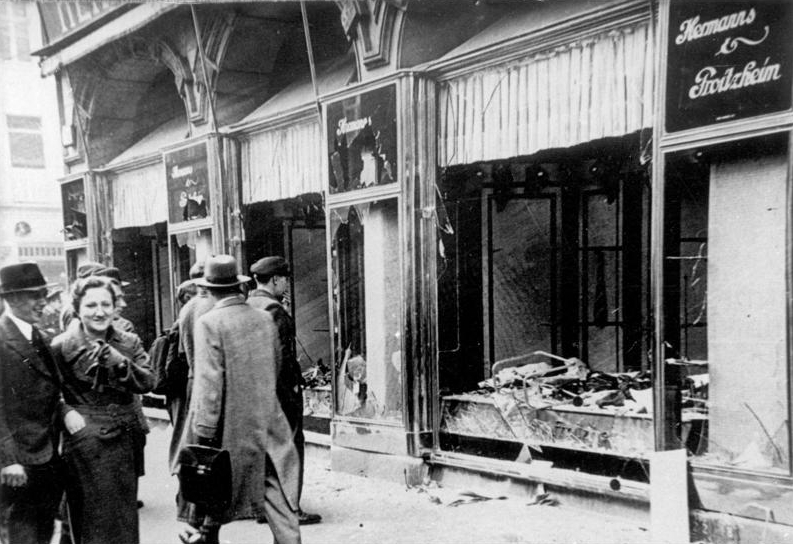On the night of 9 November 1938 violence against the Jewish population erupted in many cities throughout the Third Reich.
Businesses and houses were demolished, synagogues were put on fire and Jews were harassed, arrested and physically abused. This night became known as the Kristallnacht – or in English the Night of Broken Glass – after the glass splinters of the numerous broken windows.
The direct inducement for the Kristallnacht was the shooting and following death of Ernst vom Rath, the third secretary of the German Embassy in Paris. The perpetrator was Herschel Grynszpan, a seventeen year old Polish Jew who grew up in Germany and studied in Paris. His family was expelled from Germany to Poland in October 1938, together with about fourteen thousand others. The Polish authorities refused to let the Jews enter, which led to thousands of people getting stuck by the border in bare conditions for weeks. As a protest to the way his family was treated, Grynszpan went to the German embassy on 7 November 1938 where he shot vom Rath.
The expulsion of the Polish Jews was not the first anti-Jewish policy of the Nazis. Several laws aimed at the exclusion of Jews from the German social, cultural and economic life had been introduced since the Nazi's seizure of power in 1933. One of the most outstanding policies was the implementation of the Nuremberg laws of 1935, including the Reich Citizenship Law that determined who was a Jew. As a result, those identified as Jews lost their German citizen's rights. The policies were intended to force Jews to flee the country, yet they also laid the foundations for the anti-Semitic acts of violence which had been occurring in these years in the Third Reich.
The Nazi leadership, however, still sought an opportunity to culminate the aggression and the attack on vom Rath provided them with the necessary pretext for which they had been waiting. The German media, instructed by the Propaganda Minister Joseph Goebbels, reported massively on the attack, calling for revenge. In reaction, several riots occurred in the following days. Vom Rath eventually died on 9 November, the same day as the commemoration of the Beer Hall Putsch1 was taking place. Hitler and Goebbels received the news of his death in the midst of the celebrations. Hitler left the festivities without giving his annual address. Instead, Goebbels delivered a speech in which he strongly condemned the 'Jewish' attack and used the opportunity to encourage people to take revenge. He informed the gathered crowd that the Nazi party would not organise any official demonstrations, but assured that if the German people wished to take action, they would not be interrupted by the police.
This 'permission' from Goebbels ignited a pogrom against Jews throughout the Third Reich. The outbreak of violence was portrayed as spontaneous, yet it mostly occurred under the leadership of the Sturmabteilung (SA) which was acting on instructions from the government. On the night of 9 November and during the following day, 267 synagogues were put on fire and Torah scrolls and other ritual objects were destroyed. Jewish houses and over 7.000 businesses were ransacked and demolished, while the Jewish people had to endure harassment, rape and beatings. Approximately 100 Jews died as a result of the attacks. The police and fire departments were instructed to not interfere unless German property or foreign people were endangered. Furthermore, the orders demanded the arrest of 30.000 healthy Jewish men, who would be send to concentration camps. In many places the violence continued until the night of 10 November and in some cases even endured for several days.
During the events, a significant minority did actively participate in the acts of violence, but the greatest part of German society remained bystanders and afterwards condemned the actions of the Kristallnacht. The disapproval, however, often did not come from empathy for the Jewish compatriots, but from the distaste for chaos caused by the pogrom. The German government responded by collectively fining the Jewish population. An amount of one billion Marks had to be paid for reparations of the destructions, while all the insurance money of the Jewish people was confiscated by the state.
The events of the Kristallnacht made it abundantly clear that it was not safe for Jews to stay in Germany, and thus led to an increase in Jewish emigration – something the German government did not object. As a result, some countries decided to heighten their immigrant quotas. The British government, for example, formalized the Kindertransport: Jewish children and teenagers from the Third Reich were given the opportunity to migrate to the United Kingdom. Yet while the international community condemned the Kristallnacht, no real diplomatic repercussions were undertaken.
The events of 1938 constituted the first open pogrom against Jews in the Third Reich – and the last, due to the citizens' disapproval of the public chaos. The Kristallnacht demonstrated, however, that the German society was not opposing extreme measures against Jews per se, which encouraged the Nazi officials to take their policies even further, just in a more discreet manner. The pogrom is therefore generally regarded by scholars as a prelude to the Holocaust.
by Jolinke Golbach
1 Hitler's coup attempt on 8-9 November 1923 is called the Beer Hall Putsch after the starting point in the Bürgerbräu Keller in Munich. The coup failed, but was celebrated in Nazi history.
Bibliography:
Bard, Mitchell G., 48 Hours of Kristallnacht. Night of Destruction/Dawn of the Holocaust: An Oral History,The Lyons Press, Guilford, 2008.
Benz, Wolfgang, A Concise History of the Third Reich, University of California Press, Berkeley, 2006.
Bergen, Doris L., War and Genocide. A Concise History of the Holocaust, Rowman & Littlefield Publisher, Plymouth, 2009.
Roseman, Mark, "The Holocaust in European History" in Doumanis, Nicholas (eds.), The Oxford Handbook of European History, 1914-1945, Oxford University Press, Oxford, 2016.
Steinweis, Alan E., Kristallnacht 1938, The Belknap Press of Harvard University Press, Cambridge, 2009.
